Hu Cao
BiSeg-SAM: Weakly-Supervised Post-Processing Framework for Boosting Binary Segmentation in Segment Anything Models
Apr 02, 2025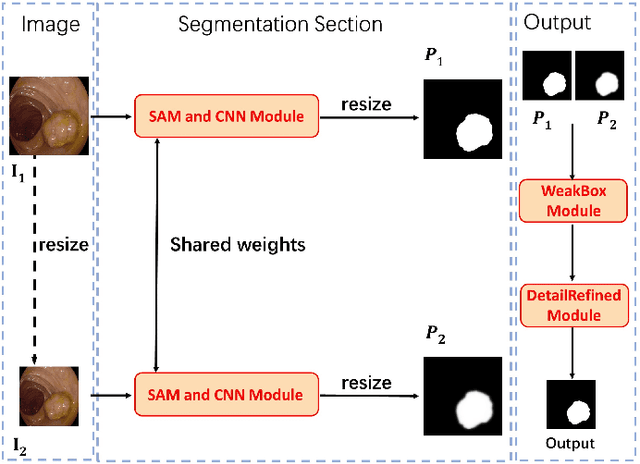
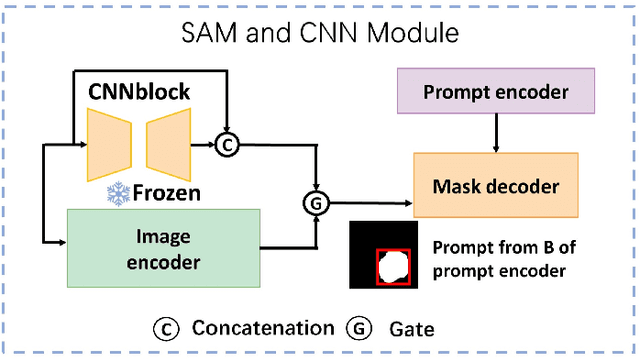
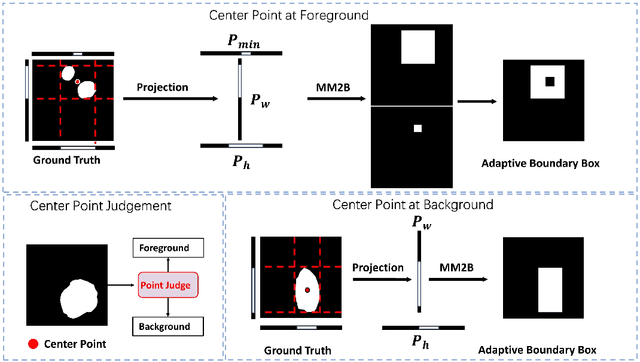
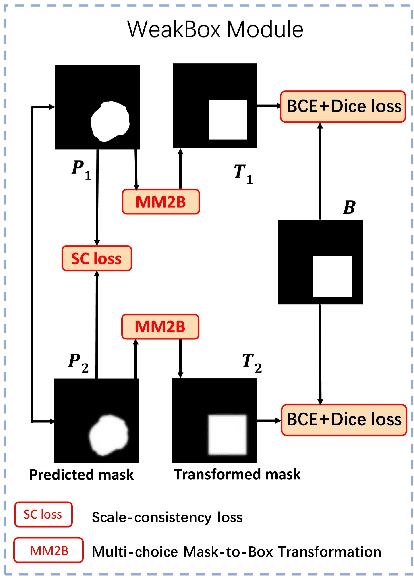
Abstract:Accurate segmentation of polyps and skin lesions is essential for diagnosing colorectal and skin cancers. While various segmentation methods for polyps and skin lesions using fully supervised deep learning techniques have been developed, the pixel-level annotation of medical images by doctors is both time-consuming and costly. Foundational vision models like the Segment Anything Model (SAM) have demonstrated superior performance; however, directly applying SAM to medical segmentation may not yield satisfactory results due to the lack of domain-specific medical knowledge. In this paper, we propose BiSeg-SAM, a SAM-guided weakly supervised prompting and boundary refinement network for the segmentation of polyps and skin lesions. Specifically, we fine-tune SAM combined with a CNN module to learn local features. We introduce a WeakBox with two functions: automatically generating box prompts for the SAM model and using our proposed Multi-choice Mask-to-Box (MM2B) transformation for rough mask-to-box conversion, addressing the mismatch between coarse labels and precise predictions. Additionally, we apply scale consistency (SC) loss for prediction scale alignment. Our DetailRefine module enhances boundary precision and segmentation accuracy by refining coarse predictions using a limited amount of ground truth labels. This comprehensive approach enables BiSeg-SAM to achieve excellent multi-task segmentation performance. Our method demonstrates significant superiority over state-of-the-art (SOTA) methods when tested on five polyp datasets and one skin cancer dataset.
Towards Vision Zero: The Accid3nD Dataset
Mar 15, 2025Abstract:Even though a significant amount of work has been done to increase the safety of transportation networks, accidents still occur regularly. They must be understood as unavoidable and sporadic outcomes of traffic networks. No public dataset contains 3D annotations of real-world accidents recorded from roadside sensors. We present the Accid3nD dataset, a collection of real-world highway accidents in different weather and lighting conditions. It contains vehicle crashes at high-speed driving with 2,634,233 labeled 2D bounding boxes, instance masks, and 3D bounding boxes with track IDs. In total, the dataset contains 111,945 labeled frames recorded from four roadside cameras and LiDARs at 25 Hz. The dataset contains six object classes and is provided in the OpenLABEL format. We propose an accident detection model that combines a rule-based approach with a learning-based one. Experiments and ablation studies on our dataset show the robustness of our proposed method. The dataset, model, and code are available on our website: https://accident-dataset.github.io.
CoDa-4DGS: Dynamic Gaussian Splatting with Context and Deformation Awareness for Autonomous Driving
Mar 09, 2025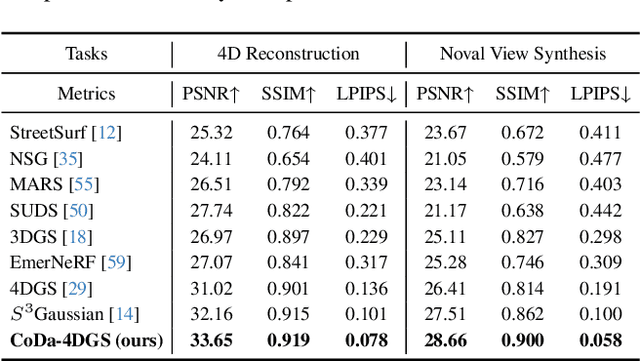

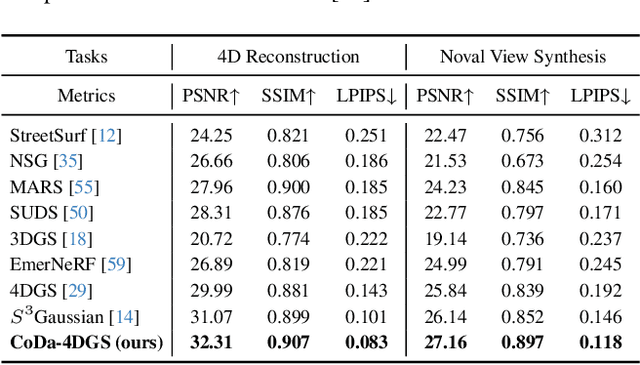
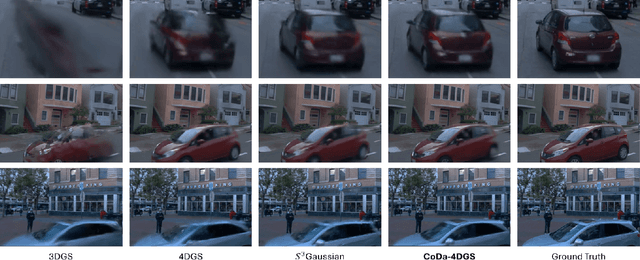
Abstract:Dynamic scene rendering opens new avenues in autonomous driving by enabling closed-loop simulations with photorealistic data, which is crucial for validating end-to-end algorithms. However, the complex and highly dynamic nature of traffic environments presents significant challenges in accurately rendering these scenes. In this paper, we introduce a novel 4D Gaussian Splatting (4DGS) approach, which incorporates context and temporal deformation awareness to improve dynamic scene rendering. Specifically, we employ a 2D semantic segmentation foundation model to self-supervise the 4D semantic features of Gaussians, ensuring meaningful contextual embedding. Simultaneously, we track the temporal deformation of each Gaussian across adjacent frames. By aggregating and encoding both semantic and temporal deformation features, each Gaussian is equipped with cues for potential deformation compensation within 3D space, facilitating a more precise representation of dynamic scenes. Experimental results show that our method improves 4DGS's ability to capture fine details in dynamic scene rendering for autonomous driving and outperforms other self-supervised methods in 4D reconstruction and novel view synthesis. Furthermore, CoDa-4DGS deforms semantic features with each Gaussian, enabling broader applications.
TUMTraffic-VideoQA: A Benchmark for Unified Spatio-Temporal Video Understanding in Traffic Scenes
Feb 04, 2025



Abstract:We present TUMTraffic-VideoQA, a novel dataset and benchmark designed for spatio-temporal video understanding in complex roadside traffic scenarios. The dataset comprises 1,000 videos, featuring 85,000 multiple-choice QA pairs, 2,300 object captioning, and 5,700 object grounding annotations, encompassing diverse real-world conditions such as adverse weather and traffic anomalies. By incorporating tuple-based spatio-temporal object expressions, TUMTraffic-VideoQA unifies three essential tasks-multiple-choice video question answering, referred object captioning, and spatio-temporal object grounding-within a cohesive evaluation framework. We further introduce the TUMTraffic-Qwen baseline model, enhanced with visual token sampling strategies, providing valuable insights into the challenges of fine-grained spatio-temporal reasoning. Extensive experiments demonstrate the dataset's complexity, highlight the limitations of existing models, and position TUMTraffic-VideoQA as a robust foundation for advancing research in intelligent transportation systems. The dataset and benchmark are publicly available to facilitate further exploration.
UniLoc: Towards Universal Place Recognition Using Any Single Modality
Dec 16, 2024Abstract:To date, most place recognition methods focus on single-modality retrieval. While they perform well in specific environments, cross-modal methods offer greater flexibility by allowing seamless switching between map and query sources. It also promises to reduce computation requirements by having a unified model, and achieving greater sample efficiency by sharing parameters. In this work, we develop a universal solution to place recognition, UniLoc, that works with any single query modality (natural language, image, or point cloud). UniLoc leverages recent advances in large-scale contrastive learning, and learns by matching hierarchically at two levels: instance-level matching and scene-level matching. Specifically, we propose a novel Self-Attention based Pooling (SAP) module to evaluate the importance of instance descriptors when aggregated into a place-level descriptor. Experiments on the KITTI-360 dataset demonstrate the benefits of cross-modality for place recognition, achieving superior performance in cross-modal settings and competitive results also for uni-modal scenarios. Our project page is publicly available at https://yan-xia.github.io/projects/UniLoc/.
Dataset Distillation by Automatic Training Trajectories
Jul 19, 2024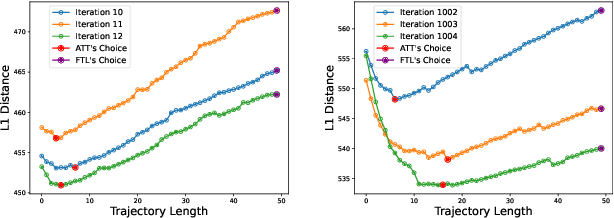



Abstract:Dataset Distillation is used to create a concise, yet informative, synthetic dataset that can replace the original dataset for training purposes. Some leading methods in this domain prioritize long-range matching, involving the unrolling of training trajectories with a fixed number of steps (NS) on the synthetic dataset to align with various expert training trajectories. However, traditional long-range matching methods possess an overfitting-like problem, the fixed step size NS forces synthetic dataset to distortedly conform seen expert training trajectories, resulting in a loss of generality-especially to those from unencountered architecture. We refer to this as the Accumulated Mismatching Problem (AMP), and propose a new approach, Automatic Training Trajectories (ATT), which dynamically and adaptively adjusts trajectory length NS to address the AMP. Our method outperforms existing methods particularly in tests involving cross-architectures. Moreover, owing to its adaptive nature, it exhibits enhanced stability in the face of parameter variations.
Embracing Events and Frames with Hierarchical Feature Refinement Network for Object Detection
Jul 17, 2024



Abstract:In frame-based vision, object detection faces substantial performance degradation under challenging conditions due to the limited sensing capability of conventional cameras. Event cameras output sparse and asynchronous events, providing a potential solution to solve these problems. However, effectively fusing two heterogeneous modalities remains an open issue. In this work, we propose a novel hierarchical feature refinement network for event-frame fusion. The core concept is the design of the coarse-to-fine fusion module, denoted as the cross-modality adaptive feature refinement (CAFR) module. In the initial phase, the bidirectional cross-modality interaction (BCI) part facilitates information bridging from two distinct sources. Subsequently, the features are further refined by aligning the channel-level mean and variance in the two-fold adaptive feature refinement (TAFR) part. We conducted extensive experiments on two benchmarks: the low-resolution PKU-DDD17-Car dataset and the high-resolution DSEC dataset. Experimental results show that our method surpasses the state-of-the-art by an impressive margin of $\textbf{8.0}\%$ on the DSEC dataset. Besides, our method exhibits significantly better robustness (\textbf{69.5}\% versus \textbf{38.7}\%) when introducing 15 different corruption types to the frame images. The code can be found at the link (https://github.com/HuCaoFighting/FRN).
Collaborative Semantic Occupancy Prediction with Hybrid Feature Fusion in Connected Automated Vehicles
Feb 12, 2024Abstract:Collaborative perception in automated vehicles leverages the exchange of information between agents, aiming to elevate perception results. Previous camera-based collaborative 3D perception methods typically employ 3D bounding boxes or bird's eye views as representations of the environment. However, these approaches fall short in offering a comprehensive 3D environmental prediction. To bridge this gap, we introduce the first method for collaborative 3D semantic occupancy prediction. Particularly, it improves local 3D semantic occupancy predictions by hybrid fusion of (i) semantic and occupancy task features, and (ii) compressed orthogonal attention features shared between vehicles. Additionally, due to the lack of a collaborative perception dataset designed for semantic occupancy prediction, we augment a current collaborative perception dataset to include 3D collaborative semantic occupancy labels for a more robust evaluation. The experimental findings highlight that: (i) our collaborative semantic occupancy predictions excel above the results from single vehicles by over 30%, and (ii) models anchored on semantic occupancy outpace state-of-the-art collaborative 3D detection techniques in subsequent perception applications, showcasing enhanced accuracy and enriched semantic-awareness in road environments.
VLTSeg: Simple Transfer of CLIP-Based Vision-Language Representations for Domain Generalized Semantic Segmentation
Dec 04, 2023Abstract:Domain generalization (DG) remains a significant challenge for perception based on deep neural networks (DNN), where domain shifts occur due to lighting, weather, or geolocation changes. In this work, we propose VLTSeg to enhance domain generalization in semantic segmentation, where the network is solely trained on the source domain and evaluated on unseen target domains. Our method leverages the inherent semantic robustness of vision-language models. First, by substituting traditional vision-only backbones with pre-trained encoders from CLIP and EVA-CLIP as transfer learning setting we find that in the field of DG, vision-language pre-training significantly outperforms supervised and self-supervised vision pre-training. We thus propose a new vision-language approach for domain generalized segmentation, which improves the domain generalization SOTA by 7.6% mIoU when training on the synthetic GTA5 dataset. We further show the superior generalization capabilities of vision-language segmentation models by reaching 76.48% mIoU on the popular Cityscapes-to-ACDC benchmark, outperforming the previous SOTA approach by 6.9% mIoU on the test set at the time of writing. Additionally, our approach shows strong in-domain generalization capabilities indicated by 86.1% mIoU on the Cityscapes test set, resulting in a shared first place with the previous SOTA on the current leaderboard at the time of submission.
Transformation Decoupling Strategy based on Screw Theory for Deterministic Point Cloud Registration with Gravity Prior
Nov 02, 2023Abstract:Point cloud registration is challenging in the presence of heavy outlier correspondences. This paper focuses on addressing the robust correspondence-based registration problem with gravity prior that often arises in practice. The gravity directions are typically obtained by inertial measurement units (IMUs) and can reduce the degree of freedom (DOF) of rotation from 3 to 1. We propose a novel transformation decoupling strategy by leveraging screw theory. This strategy decomposes the original 4-DOF problem into three sub-problems with 1-DOF, 2-DOF, and 1-DOF, respectively, thereby enhancing the computation efficiency. Specifically, the first 1-DOF represents the translation along the rotation axis and we propose an interval stabbing-based method to solve it. The second 2-DOF represents the pole which is an auxiliary variable in screw theory and we utilize a branch-and-bound method to solve it. The last 1-DOF represents the rotation angle and we propose a global voting method for its estimation. The proposed method sequentially solves three consensus maximization sub-problems, leading to efficient and deterministic registration. In particular, it can even handle the correspondence-free registration problem due to its significant robustness. Extensive experiments on both synthetic and real-world datasets demonstrate that our method is more efficient and robust than state-of-the-art methods, even when dealing with outlier rates exceeding 99%.
 Add to Chrome
Add to Chrome Add to Firefox
Add to Firefox Add to Edge
Add to Edge